Transport in Kuala Lumpur
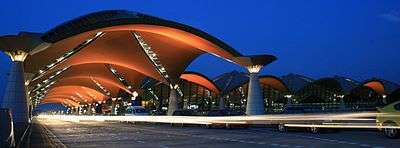
The transport of Kuala Lumpur consists of highly developed intermodal infrastructure in the Klang Valley. Kuala Lumpur, being the capital of Malaysia, has an unrivaled transport system in Malaysia, including an integrated rail network, and to a further extent, one of the longest automated driverless metro systems in the world, the Kelana Jaya Line.
Despite all the efforts to promote public transport, the average use in the city is only mere 16 percent in 2006, among the lowest in Asia.[1]
Kuala Lumpur has the country's largest airport, Kuala Lumpur International Airport, as well as South East Asia's largest intermodal transport hub, the Kuala Lumpur Sentral transport hub.
History
The first airport in Kuala Lumpur, Simpang Airport, commenced operation in 1952, and was the main airport for Malaysia until 1965. In 1965 Subang Airport started service. The Kuala Lumpur Mini Bus service is one of the oldest bus services in Malaysia and commenced operation in 1975.[2]Taxis have been a common sight in Kuala Lumpur ever since the 1950s, and in the 1970s and 1980s the Morris Oxford was a common model used as a taxi.
Cycling
Public transport
Metro or Rapid Transit
Kuala Lumpur's metro or rapid transit system consists of 6 metro lines operated by 4 operators. Among the 4 operators, Rapid Rail and KTM Komuter are the most important rail operators in Kuala Lumpur where Keretapi Tanah Melayu alone carries 30,934,651 passengers in year 2005.[3] Metro lines in Kuala Lumpur are categorized into different types: rapid transit, commuter rail and monorail. Others such as the Intercity rail and the airport express are obviously not metro systems. It may even be argued that commuter rail services from Kuala Lumpur cannot be considered a metro system because it extends far beyond Kuala Lumpur and its immediate surroundings.
Light Rail Transit (LRT)
There are three fully grade-separated light rail transits (LRT) systems in Kuala Lumpur. The Kelana Jaya Line, Sri Petaling Line and Ampang Line. They are both operated by Rapid Rail.
Kelana Jaya Line is the most important metro line in Kuala Lumpur as it links the city centre with Subang Jaya, Petaling Jaya and Gombak, primarily serving the Subang Jaya, Petaling Jaya regions to the south; southwest and central Kuala Lumpur. Todate, it carries over 170,000 passengers a day and over 350,000 a day during national events such as National Day celebration and New Year's Eve countdown celebration. At 46.4 km in length, the Kelana Jaya Line is the second longest fully automated driverless metro system in the world, after the SkyTrain in Greater Vancouver, Canada (49.5 km).
Passengers riding the rapid transit pay with stored value cards such as Touch 'n Go, which are also valid in other transit systems in Kuala Lumpur. Apart from Touch 'n Go, monthly travel pass issued by Rapid KL is also accepted to pay fare.
.jpg)
The Ampang Line is the other rapid transit system for the two routes of the line operating in Rapid Rail network. These sub-lines are Ampang(formerly, Ampang line) and Sri Petaling (formerly, Sri Petaling line). These two lines are carrying over 130,000 to 150,000 per day on a weekday basis and an average of 120,000[4] per day on weekends. The Ampang Line consists of two routes totaling at a length of 27 kilometres that begin at two different stations at the south, meeting at an interchange station and ending at the same station at the north. Ampang Line has a total of 29 stations, with a combination of elevated and at-grade stations. However, there are no subways in the system.
Similarly, passengers riding the rapid transit pay with stored value cards such as Touch 'n Go and monthly travel pass issued by Rapid KL to pay the fare.
%2C_Klang_Valley.jpg)
Commuter Rail
Kuala Lumpur has the most extensive commuter railway system in Malaysia. Commuter rail in Kuala Lumpur is operated by two operators, which are Keretapi Tanah Melayu (English: Malayan Railways Limited) and Express Rail Link. These two operators operates 4 commuter rail lines in Kuala Lumpur, namely Port Klang Line, Seremban Line, Tanjung Malim Shuttle Service and KLIA Transit. The KLIA Transit is operated by Express Rail Link whereas the remaining 3 is operated by Keretapi Tanah Melayu, which runs under a system called KTM Komuter. All 4 commuter lines integrate in KL Sentral intermodal transport hub. The KLIA Transit commuter rail line shares the same track with KLIA Express which links Kuala Lumpur City Centre and Southern Kuala Lumpur & Klang Valley.
Airport Express
The airport express service is provided by Express Rail Link, linking Kuala Lumpur City Centre and Kuala Lumpur International Airport. The Airport rail link service between Kuala Lumpur and Kuala Lumpur International Airport only takes 28 minutes running at a maximum speed of 160 km/h. The train of the express service departs at 15 minute intervals during peak hours and 20 minute intervals during off-peak hours.
Monorail

Previously operated by KL Infrastructure Group, the monorail service in Kuala Lumpur serves as a people mover system for the city. It connects the Kuala Lumpur Sentral transport hub with the Golden Triangle. The system spans over 8.6 km, with 11 elevated stations, has 36,000 daily passengers. Since November 2007, the monorail service is taken over by Prasarana, the largest public transport operator of Kuala Lumpur.[5] Passengers may have an option of paying cash or using Touch 'n Go installed in automatic fare gate to pay the ride's fare.
Buses

Kuala Lumpur bus service is rather poor compared to other cities around the world before the bus network revamp, resulting only 16% of the total population in Klang Valley use public transport.[6]
Rapid Bus is the largest single operator of bus network in Malaysia. Since the take over from Intrakota Komposit Sdn Bhd, Rapid Bus has redrawn the entire bus network of Kuala Lumpur and Klang Valley metropolitan area to increase ridership and improve Kuala Lumpur's public transport system. The management of Prasarana has adopted the hub and spoke system to provide greater connectivity, and cutting down the need of more buses. It currently operates 177 bus routes using 849 new buses.
Bus fare charges varies with bus operator, where Rapid Bus uses daily pass system and Metrobus Nationwide, SJ Bus and Selangor Omnibus uses zoning system.
The revamp of Rapid KL bus service involved redrawing all its routes and reorganising them based on the "hub and spoke" concept. Four types of bus services were created, namely express routes (EKSPRES), city shuttles (BANDAR), trunk routes (UTAMA) and local shuttles (TEMPATAN). Buses are labelled with a number and a prefix identifying different service, E for express routes, B for city shuttles, U for trunk routes and T for local shuttles. Whereas for Metrobus Nationwide buses and others, they continue using the conventional numbering system which are considered confusing.
Each area outside Kuala Lumpur city centre has only one bus hub to feed passengers to city bus hubs. Whereas in Kuala Lumpur city centre, there are 4 bus hubs namely KL Sentral, KLCC, Maluri and Titiwangsa. Bus hubs are usually located near public transit stations such as Kelana Jaya Line transit stations. This hub and spoke service only applies to Rapid KL BUSES service.
Apart from Rapid Bus, Metrobus Nationwide is a private owned public transport company in the Klang Valley that was formed in 1992. It is the second largest stage bus and feeder bus operator in Kuala Lumpur after Rapid Bus. Metrobus Nationwide owns a fleet of Nissan Diesel, Hino, Silverbus and Mercedes Benz buses but buses are below service standards.
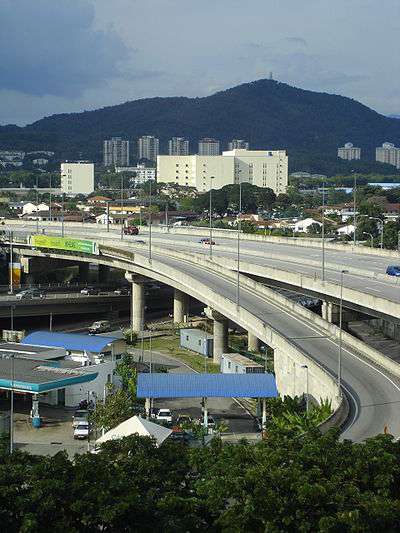
Intercity transport
Intercity Rail
The Intercity rail is operated by Malaysia's largest railway operator Keretapi Tanah Melayu. The KTM Intercity railway network is part of the Trans-Asian Railway where it is linked to Singapore and Thailand. There are two types of KTM intercity train services namely express trains, which provide point-to-point service and mail trains. Almost all intercity trains originate from KL Sentral, whereas some originate from Gemas. Among all services, KL-Singapore route has the highest number of passengers, which was 466,000 in 2005.[7]
The Intercity service serves major cities in Malaysia, as well as Singapore and Bangkok.
ETS is the electric train service operates between Padang Besar which is a small city nearby international border of Malaysia-Thailand to Gemas nearby state border of Negeri Sembilan-Johor. All train routes can be identified using code EGXXXX. KL Sentral-Ipoh, KL Sentral-Butterworth, KL Sentral-Padang Besar, Ipoh-Butterworth, Ipoh-Padang Besar and Gemas-Padang Besar are the major routes for these service. Trains travel can speed up to 160km/h using 1,000 meter gauge.
Kuala Lumpur - Singapore High Speed Rail
Plans are underway to construct Asia's first transnational high-speed rail system (HSR). The proposal was mooted by the Najib Razak administration is September 2010 under the Economic Transformation Programme initiative. It is envisaged to link Penang, Kuala Lumpur with Singapore.
Roads
Roads are the major arteries of Kuala Lumpur's transport network. The road network system in Kuala Lumpur is similar to the city road network system in major Chinese cites, where it has ring roads. The main ring roads in Kuala Lumpur are Kuala Lumpur Inner Ring Road, Kuala Lumpur Middle Ring Road 1 and Kuala Lumpur Middle Ring Road 2. Roads in Kuala Lumpur are usually 3 lanes in each direction, and certain roads such as Jalan Sultan Ismail and Jalan Bukit Bintang are one-way streets.[8]
- Expressways
Expressways in Kuala Lumpur are tolled roads. They serve as an alternative during peak periods at which time some parts of Kuala Lumpur's ring roads become highly congested. Kuala Lumpur is well connected by many intracity expressways such as the Ampang-Kuala Lumpur Elevated Highway. Moreover, Kuala Lumpur is the home for the world's first[9] SMART Tunnel, which is a unique solution to Kuala Lumpur's long-term traffic problems and floodwater mitigation woes.
Most expressways in Kuala Lumpur adopt an open toll collection system. NKVE is the only closed toll system in Klang Valley. In the open toll system, the user pays the toll at each toll plaza, while for the closed toll system, the tolls are to be paid at the toll plazas when exiting the expressway. Payment options includes cash, stored value card Touch 'n Go or the electronic toll collection system SmartTAG.
Access from the city to the surrounding areas are facilitated by a series of expressways which is both integrated and complex. From the city centre to the south-western areas, access is provided mainly from Federal Highway which connects the city to Klang and bridging Petaling Jaya, Subang Jaya, Kelana Jaya and Shah Alam. New Pantai Expressway provides an alternative route to Subang Jaya, bypassing the morning and evening traffic congestion on the Federal Highway. An alternative connection to Shah Alam, Subang Jaya and Klang is provided by New Klang Valley Expressway which connects with the Sprint Expressway. This connects the city centre to Damansara, to the west. The New Klang Valley Expressway also provides connections to Sungai Buloh and Kepong and is linked to the northern section of the North-South Expressway, which provides access to northern states like Perak, Penang and Kedah. Connection from Damansara in the northwest to Puchong in the south-west of Kuala Lumpur is facilitated by Damansara-Puchong Expressway, which also provides connection to Putrajaya.
Access from the city centre to southern areas is provided by Sungai Besi Expressway, which leads to the Bukit Jalil and Sungai Besi areas. The highway runs in parallel with the Kuala Lumpur-Seremban Expressway. The highway also provides an alternative route to Kajang by connecting with Kajang Dispersal Link Expressway.
Access from the city centre to south-eastern areas is provided by Cheras Highway which connects to Cheras. The highway is connected with Cheras - Kajang Expressway, which provides access to Kajang and that highway itself is connected with Kajang-Seremban Highway and Kajang Dispersal Link Expressway, giving alternative access to Seremban and southern parts of the city.
Connection from the city centre to eastern areas is provided by Ampang-Kuala Lumpur Elevated Highway. The highway is connected to Kuala Lumpur Middle Ring Road 2 for access to Batu Caves and Gombak. In close proximity with Karak Expressway, it provides access to the east coast area of Malaysia. There is no dedicated highway leading from the city centre to the northern areas such as Batu Caves However, Jalan Kuching is the main road from the city to the northern area.
The MMR2 connects with KESAS Highway which provides yet another alternative route to Shah Alam and Subang Jaya. The KESAS highway also has connections to Kuala Lumpur-Seremban Expressway which integrates with the southern section of North-South Expressway and North-South Expressway Central Link which provide access to Kuala Lumpur International Airport.
Connection from the city to Putrajaya is facilitated by a direct highway, Kuala Lumpur-Putrajaya Expressway which also provide connections to Kuala Lumpur International Airport through North-South Expressway Central Link. The highway also provides alternative access to southern areas of the city such as Puchong and Bukit Jalil.
Below is a non-exhaustive list of expressway serving the Klang Valley area:
Taxis
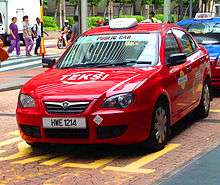
Metered taxis or 'Teksi Bermeter' in Malay can be hailed throughout the city. However, traffic jams, especially during rush hour are fairly common in KL and it might be difficult to get a taxi during rush hour. There have been many incidents of taxi drivers charging extravagant fares, especially among tourists, therefore, tourists are advised to travel with taxis who charge fare according to meters, or insist on using the meter.
Taxi stands are available around the city and most taxis will stop at the taxi stand. Taxis in Kuala Lumpur are coloured in various colours such as a combination of red-white, red, yellow-blue, green or yellow. However, taxis could be easily recognised as the taxis' vehicle registration number carries a prefix H and LIMO for airport limousine.
Intermodal transport hub
There are various intermodal transport hubs in Kuala Lumpur, with one major intermodal transport hub in the city centre of Kuala Lumpur, the Kuala Lumpur Sentral transport hub.
- Kuala Lumpur Sentral
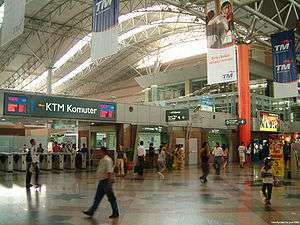
Kuala Lumpur Sentral (KL Sentral) or Sentral Kuala Lumpur is a transit-oriented development that houses the main railway station of Kuala Lumpur, which has officially taken over the role of Kuala Lumpur Railway Station. It is the largest railway station in Southeast Asia.
Stesen Sentral is designated the transport hub within its KL Sentral development project, although both the public and connected transit lines generally refer to the station itself as "KL Sentral". Among rail lines in Kuala Lumpur, Kelana Jaya Line, KL Monorail, KTM Komuter, KTM Intercity, KLIA Ekspres and KLIA Transit integrate in this railway station.
Located within Stesen Sentral, the KL City Air Terminal (KL CAT) is virtually an extension of the Kuala Lumpur International Airport. KL CAT also has luggage check-in services. Currently, only passengers flying Malaysia Airlines, Cathay Pacific, Emirates and Royal Brunei Airlines can check in their luggage at KL CAT. KL Sentral has also been made a city bus hub by RapidKL under its bus network revamp. It is the bus hub for city shuttle bus (BANDAR) and trunk routes(UTAMA). Furthermore, some buses departing to Kuala Lumpur International Airport's Low Cost Carrier Terminal also originate from KL Sentral.
Stesen Sentral will be able to accommodate 50 million passengers a year and up to 100 million by 2020.
- Puduraya
Puduraya is the main bus terminus for Kuala Lumpur. Long-distance buses arrive and leave from Puduraya for all over Malaysia. Under Kuala Lumpur 2020 Structural Plan, there are plans to move some bus operators to inter-regional hubs in other parts of Kuala Lumpur such as Perhentian Duta, Gombak Hub and Bandar Tasik Selatan hub to avoid massive congestion in Puduraya.[10]
Puduraya is accessible via Ampang Line, at Plaza Rakyat Station
Port Infrastructure
Airports

Kuala Lumpur is the main gateway for Malaysia as it has the country biggest airport, Kuala Lumpur International Airport, about 25 million passengers used the airport, making it the busiest airport in Malaysia.[11]
The city is served by 2 airports, which is Kuala Lumpur International Airport and Sultan Abdul Aziz Shah Airport(formerly. Subang International Airport). Both airports have international connections, but Sultan Abdul Aziz Shah Airport is solely for turboprop aircraft and private jets only.[12] Kuala Lumpur International Airport apart from being the main passenger gateway, it is also the main cargo destination in Malaysia by cargo traffic.[11] Kuala Lumpur International Airport is linked to the city centre by KLIA Express by railway, major expressways and bus service. Whereas Subang Airport is well connected by road networks and bus service.
Kuala Lumpur International Airport (KLIA) is capable of handling 35 million passengers and 1.2 million tonnes of cargo a year in its current phase. It is currently ranked as the 13th busiest airport in the world by international passenger traffic where it has handled 24,129,748 passengers in the year of 2006. In the same year, it is also ranked 30th busiest airport in the world by cargo traffic where it has handled 677 446 metric tonnes of cargo.[13] Kuala Lumpur International Airport is one of the only few airports in East Asia to have links to South America, where Malaysia Airlines, has flights out of Kuala Lumpur International Airport to Buenos Aires via Johannesburg and Cape Town.
Both airports are operated by Malaysia Airports and is the hub for Malaysia Airlines, Malaysia Airlines Cargo, AirAsia and AirAsia X in Kuala Lumpur International Airport and Firefly, Transmile Air Services and Berjaya Air in Subang Airport. Moreover, KLIA is also the stopover point for the kangaroo route for Malaysia Airlines.
Ports
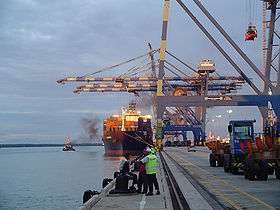
Port Klang is one of the main sea ports of Malaysia, located in the district of Klang in the state of Selangor. It serves the Klang Valley, including the federal capital Kuala Lumpur and federal administrative capital Putrajaya.
Port Klang was originally known as Port Swettenham when it was founded under British colonial rule in 1893, after the then British Resident High Commissioner for the Malay State, Sir Frank Swettenham. Official opening of the port was on 15 September 1901, which developed as a new port after a study found that its coastal area had a harbour with deep anchorage, free from dangers and very suitable for wharves. Its development was accelerated further with the extension of a railway line from Kuala Lumpur to the new port. The Port Klang Authority, established 1 July 1963, administers the three ports in the Port Klang area: Northport, Southpoint and West Port. As of November 2007, West Port, part of the three ports in Port Klang, has handled 4 million twenty-foot equivalent units (TEU) worth of containerised cargo, and is moving towards its 4.3 millionth TEU by end of 2007. Together with North port and South port, Port Klang handled 7.12 million TEU of containerised cargo and 133.5 million tonnes of conventional cargo in 2007.[14]
Apart from cargo ships, Port Klang also features a cruise ship terminal in Westport where SuperStar Virgo and Queen Mary 2,[15] the world's second largest passenger ship has docked in the terminal for excursion. Port Klang is also the home port of call for SuperStar Gemini.
Port Klang has its own free zone, called Port Klang Free Zone (PKFZ). It is an integrated 1,000-acre (4.0 km2) international cargo distribution and consolidation centre situated in Port Klang, the world’s 13th ranked port in 2005 in terms of throughput volume.[16] The PKFZ is designed to promote entreport trade and manufacturing industries involved in producing goods primarily for export. In 2007, PKFZ Authority has secured USD 220 million and projected to secure another USD 184 million[17] in 2008. The project is similar to Dubai's Jebel Ali Free Zone, which previously PKFZ is managed by Jebel Ali Free Zone Authority (JAFZA).
Port Klang is well connected by road and railway networks. On rail, Port Klang is connected by Keretapi Tanah Melayu, whereas by road, Port Klang is connected by Federal Highway and Shah Alam Expressway
Future Projects
Plaza Rakyat
Plaza Rakyat is a mixed used skyscraper complex initiated during the 1990s that was to be completed but was halted due to the 1997 Asian financial crisis. The building was intended to replace Puduraya bus depot and also to provide better connectivity to Ampang Line's Plaza Rakyat LRT station. As of May 2013, the site remains abandoned.
LRT line extension and expansion
On 29 August 2006, Malaysian Deputy Prime Minister Mohd Najib Abdul Razak announced an RM10 billion plan to expand Kuala Lumpur's public transport network. The plan included extending the existing Kelana Jaya Line from Kelana Jaya to USJ and the Ampang Line from Sri Petaling to Puchong and USJ. The plan also will see a new light rail transit line being constructed between Kota Damansara to the northwest of Kuala Lumpur and Cheras which lies to the southeast of Kuala Lumpur. No details of the alignment of the extensions nor the locations of new stations were revealed.[18]
The Star, a local newspaper reported a new 40 km route from Cheras to Kota Damansara which traverse the city centre through Bangsar, KL Sentral, Pasar Seni and Masjid Jamek stations. The new line is expected to be ready by 2012, however, as of July 2008, no construction has started.[19]
Multi Lane Free Flow
By 2008, expressways in Kuala Lumpur will introduce Multi Lane Free Flow system similar to SmartTAG. Under the Multi Lane Free Flow, which is similar to system used extensively in Europe, the United States, Australia, Canada and Singapore, the toll changes will be deducted electronically as vehicles beating special tags pass through t plazas a normal driving speeds as fast as 180 km/h, as there will be no barriers.[20] Trails of the system is expected to be run starting November 2008 with the Sungai Pencala Toll Plaza on the Damansara-Puchong Expressway(LDP) as the test site.[21] Shah Alam toll plaza as also been selected as a new test site for the system beginning December 2008.[22]|This system will implement in 2010 by stages
Outer ring railway service
Currently in proposal phase as of April 2008, KTM propose a railway link to connect all suburbs in the Klang Valley. The 70 km line will be a circular loop and expected to link Sentul, Kepong, Sungai Buloh, Kelana Jaya, Shah Alam, Cheras and Bandar Tasik Selatan without going through the city centre.[23]
Bandar Tasik Selatan integrated transport hub
The Bandar Tasik Selatan station will be upgraded to an integrated transport hub. It is expected to serve buses coming from the south of Kuala Lumpur. Construction has started since November 2007 and expected to complete by 2010.[24] Currently, the station serves Ampang Line, Rawang-Seremban Route of the KTM Komuter and KLIA Ekspres line.
See also
- Public transport in Kuala Lumpur
- Northport, Malaysia
- Kuala Lumpur - Singapore High Speed Rail
References
- ↑ "Prasarana to buy trains worth RM1.2bil". The Star. 2006-10-13. Retrieved 2006-10-22.
- ↑ Kuala Lumpur Mini-Bus Service
- ↑ KTMB Statistics on ridership
- ↑ Amapng Line Ridership
- ↑ Prasarana new operator of KL Monorail
- ↑ "Prasarana to buy trains worth RM1.2bil". The Star. 2006-10-13. Retrieved 2006-10-22.
- ↑ KTMB Intercity Statistics
- ↑ One Way Streets in Golden Triangle
- ↑ World First Dual Purpose Road Tunnel opens
- ↑ KL 202 Structural Plan
- 1 2 Malaysia Airports 2006 Air Statistics
- ↑ Subang Airport for Turboprops only
- ↑ Airport Traffic
- ↑ Port Klang expects to handle 7.74m TEU this year
- ↑ QM2 Sails into Port Klang
- ↑ Port Klang Free Zone
- ↑ Two more new investors for PKFZ
- ↑ Mergawati Zulfakar (30 August 2006). "Rail travel expansion". The Star. Retrieved 2007-06-22.
- ↑ Leong Shen-Li (2008-06-15). "Kota Damansara-Cheras rail line right on track". The Star. Retrieved 2008-07-05.
- ↑ "Works Department of Malaysia to introduce Multi Lane Free Flow in Kuala Lumpur". Ministry of Works Malaysia. Retrieved 2007-03-08.
- ↑ "'No stop' toll trials to begin in November". The Star. 2008-07-22. Retrieved 2008-07-22.
- ↑ "Booth-free trial run at Batu Tiga". New Straits Times.
- ↑ "Commuter line for suburbs". The Star. Retrieved 2008-04-17.
- ↑ "RM570mil terminal project to proceed". The Star. 2008-07-08. Retrieved 2008-07-08.